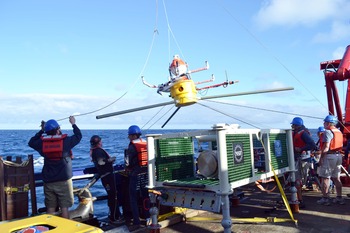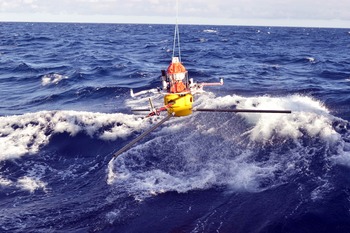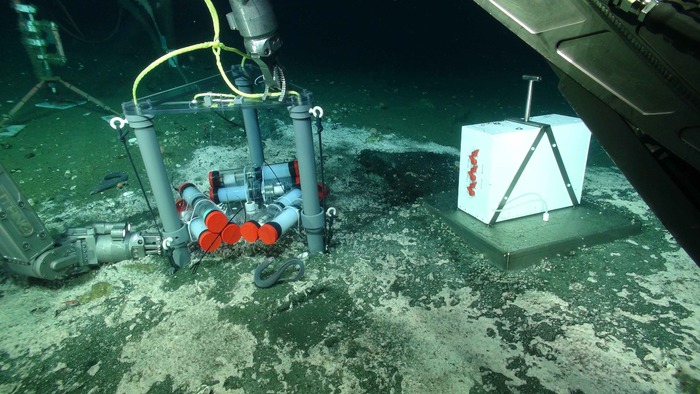
An HPIES instrument is being installed off the starboard side of the R/V Sikuliaq ~ 125 km offshore Newport Oregon near the base of the Subduction Zone. This instrument utilizes a bottom pressure sensor, an inverted echosounder and a horizontal electrometer to provide insights into the vertical structure of current fields, near-bottom water currents, and water properties including temperature, salinity, and specific volume anomalies. It was built at the Applied Physics Laboratory. Credit: M. Elend, University of Washington, V16.

An HPIES instrument deployed off the starboard side of the R/V Sikuliaq ~ 125 km offshore Newport Oregon near the base of the Subduction Zone. The instrument was released and free fell over 9000 ft to land softly on the seafloor - the extended legs insure a softer landing and that is stays nearly horizonatal as it travels throught the water column. This instrument utilizes a bottom pressure sensor, an inverted echosounder and a horizontal electrometer to provide insights into the vertical structure of current fields, near-bottom water currents, and water properties including temperature, salinity, and specific volume anomalies. It was built at the Applied Physics Laboratory. Credit: M. Elend, University of Washington, V16.
Our eyes have been on the weather since leaving dropping he RAPP winch technician in Newport Oregon by small boat. Winds and seas are expected to build and so we are working hard on getting operations completed at Southern Hydrate Ridge.
Early on the morning of July 23, Jason went into the water at Southern Hydrate Ridge, taking an osmotic fluid sampler and flow meter to the seafloor in the elevator latched beneath the vehicle. The geologists and chemists onboard are always eager to see/experience this extremely active and dynamic site since it changes so dramatically from year to year. Here, degassing of methane ice deposits in the subsurface support dense microbial communities on and beneath the seafloor, which metabolize methane and sulfate in the pore fluids and those seeping out of the sediments. It is easy to see where the methane-rich fluids egress because these areas are marked by thick white mats of microbes, rimmed by hundreds of clams that host symbionts.
The dive predominantly focused on the area around Einstein’s Grotto, which has changed remarkably in the past few years – it is nearly unrecognizable with the development of extensive hummocks (presumably underlain by methane hydrate), extensive development of bacterial mats, and a significant collapse area with a large orifice at the base of the hummock, hence called Einstein’s Grotto. A nascent venting site appears to be developing a few meters to the west.
During the dive (J2-292) Jason recovered two uncabled flow meters that use chemical tracers in the instruments that allow scientists to track the flow of seawater into the seafloor and the flow of methane-rich fluids outward into the overlying ocean. Once the fluid chemistry of the recovered fluids within the instruments is analyzed onshore, fluid flux calculations can be completed. The hope is that these “flux measurements”, when combined with measurement of methane concentrations from the associated in situ cabled mass spectrometer, will help inform the community on how much methane is reaching the hydrosphere. A new flow meter was installed (a Mosquito) that partners with another flow meter called a CAT, and an osmotic fluid sampler was also installed. This instrument allows seep fluids to diffuse into a small capillary tube many many tens of feet in length. The diffusion rate is known, such that once this instrument is recovered, small sections of tube are cut (about three feet in length), the fluids are drained into small vials, and then the chemistry of the fluids is measured onshore. This allows monitoring of changes in fluid chemistry at nearly daily resolutions. Near the end of the dive, Jason investigated the digital still camera at Einsteins’ Grotto that had been previously installed and a “selfie” of Jason on the seafloor was taken with the digital still camera. On a rapid follow-on dive, the mass spectrometer was recovered and reinstalled – completing this years work at Southern Hydrate Ridge.
With weather coming in, the R/V Sikuliaq transited a couple hours to the Slope Base site to install the HPIES instrument – this is a novel instrument that provides measurement of currents, and heat content over large vertical ocean volumes, as well as providing information about salinity and temperature. It was designed and built by the Applied Physics Laboratory at the UW. During transit, July 24th, the engineers made final rigging preparations of the instrument, which is deployed off the side of the ship and then connected to the cable using Jason. Although we had beautiful blue skies for this deployment, the winds and seas had built over the few hours of transit. It was decided that it would be too risky to dive with Jason to recover the HPIES instrument installed last year. We will return on Leg 3 to finish this installation. With rough seas and high winds predicted for several days along the margin, the Sikuliaq began a 20 hour transit to begin work at the summit of our favorite submarine volcano, Axial Seamount.


